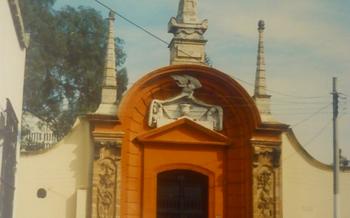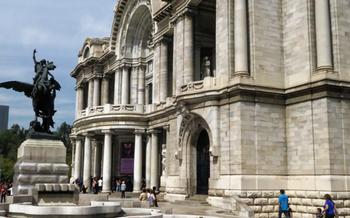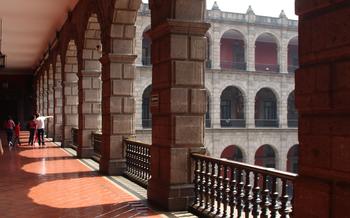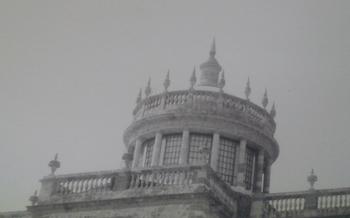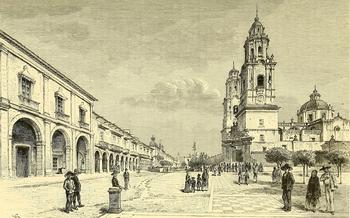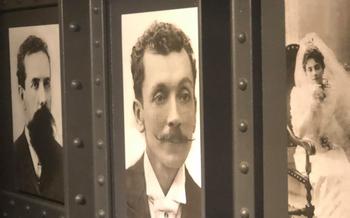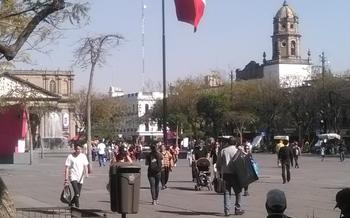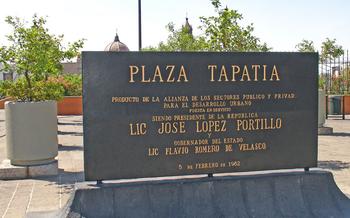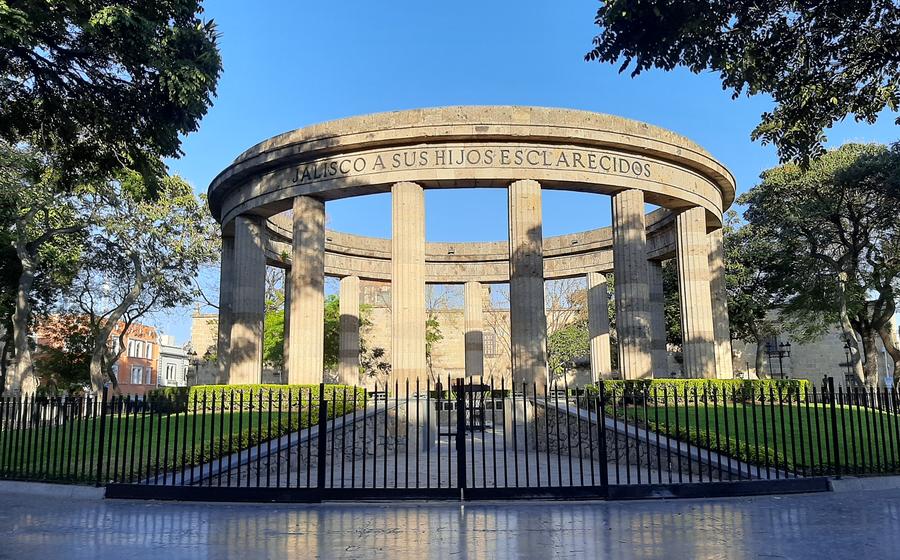
Rotonda de los Jaliscienses Ilustres
- Location and Accessibility:
- Historical Context and Significance
- Architectural Highlights
- Commemorated Personalities:
- Cultural and Artistic Significance
- Educational Value and Learning Opportunities:
- Surrounding Attractions and Points of Interest
- Local Traditions and Customs
- Photography and Social Media:
- Accessibility for Visitors with Disabilities
- Sustainable Tourism Practices
- Insider Tip:
Location and Accessibility:
The Rotonda de los Jaliscienses Ilustres is situated in the heart of Guadalajara, Mexico, at the intersection and there are designated spaces for visitors with disabilities. The Rotonda is wheelchair accessible, and visitors can request assistance from the staff if needed.
Historical Context and Significance
The Rotonda de los Jaliscienses Ilustres holds a significant place in the cultural and historical identity of Jalisco. Its construction, initiated in 1952, was driven by the desire to honor and commemorate distinguished figures from the state who had made outstanding contributions to Mexican society. The project was spearheaded by a group of prominent citizens, led by Dr. Atl, a renowned artist and cultural promoter, who recognized the need to create a space that would serve as a lasting tribute to Jalisco's cultural heritage.
The selection process for individuals to be honored in the Rotonda is rigorous and based on strict criteria. Nominees must have demonstrated exceptional achievements in their respective fields, whether in politics, arts, sciences, or social activism. Their contributions must have had a profound impact on Mexican society and culture, leaving a lasting legacy that continues to inspire future generations.
The Rotonda's inauguration in 1956 was a momentous occasion, attended by dignitaries, cultural figures, and representatives from across the state. The event marked the official recognition of the Rotonda as a symbol of Jalisco's cultural identity and a testament to the state's rich history and heritage. Since then, the Rotonda has become a place of pilgrimage for those seeking to pay homage to the individuals who have shaped Jalisco's cultural landscape.
Architectural Highlights
The Rotonda de los Jaliscienses Ilustres stands as a testament to Mexican architectural ingenuity and craftsmanship. Its unique design blends neoclassical and Art Deco elements, creating a visually striking and harmonious structure. The Rotonda's most distinctive feature is its majestic dome, which rises gracefully above the surrounding landscape. The dome is adorned with intricate tilework and features a series of stained-glass windows that depict scenes from Jalisco's history and culture.
The Rotonda's exterior is characterized by its elegant colonnade, which surrounds the entire structure. The columns are made of locally quarried stone and feature intricate carvings that showcase the skill and artistry of Mexican craftsmen. The Rotonda's walls are adorned with bas-relief sculptures that depict notable moments from Jalisco's past, further enhancing the historical and cultural significance of the site.
The interior of the Rotonda is equally impressive, with its soaring ceilings and polished marble floors. The walls are lined with niches that house the busts and statues of the illustrious figures commemorated in the Rotonda. Each bust or statue is accompanied by a plaque that provides a brief biography of the individual and their contributions to Mexican society.
The Rotonda's design not only serves an aesthetic purpose but also reflects the historical and cultural significance of the site. The use of local materials and traditional construction techniques pays homage to Jalisco's rich architectural heritage. The Rotonda's integration into the surrounding urban landscape further emphasizes its role as a symbol of Jalisco's cultural and historical identity.
Commemorated Personalities:
The Rotonda de los Jaliscienses Ilustres honors a diverse group of individuals who have made significant contributions to Mexican society and culture. Among the notable figures commemorated are:
-
Ignacio L. Vallarta: A renowned mathematician and astronomer, Vallarta was a pioneer in the field of quantum mechanics and made significant contributions to the understanding of cosmic rays.
-
José Clemente Orozco: One of Mexico's most celebrated muralists, Orozco's powerful and evocative works can be seen in many public buildings throughout the country, including the Palacio de Bellas Artes in Mexico City.
-
Juan Rulfo: A renowned novelist and short story writer, Rulfo's works, such as "Pedro Páramo" and "El llano en llamas," are considered classics of Mexican literature.
-
Mariachi Vargas de Tecalitlán: This legendary mariachi group, founded in 1898, is considered one of the most influential and successful mariachi bands in the world, having performed for audiences around the globe.
-
Dolores del Río: A prominent actress of the Golden Age of Mexican cinema, del Río starred in over 50 films and became an icon of Mexican popular culture.
These are just a few examples of the many distinguished individuals honored in the Rotonda de los Jaliscienses Ilustres. Their achievements and contributions have left an indelible mark on Mexican society and culture, and their legacies continue to inspire and motivate generations to come.
Cultural and Artistic Significance
The Rotonda de los Jaliscienses Ilustres stands as a testament to Mexican art and culture, showcasing a diverse range of artistic expressions that pay homage to Jalisco's illustrious figures. Renowned artists and architects collaborated to create a space that is both aesthetically pleasing and historically significant. The Rotonda features intricate sculptures, vibrant murals, and other artistic works that collectively narrate the stories of Jalisco's most celebrated individuals.
The sculptures, crafted with precision and detail, capture the essence of the individuals they represent, immortalizing their achievements and contributions. Murals adorn the walls of the Rotonda, depicting scenes from Mexican history and culture, adding a touch of color and vibrancy to the space. These artistic creations not only beautify the Rotonda but also serve as educational tools, providing visitors with a deeper understanding of Jalisco's rich heritage.
The Rotonda's commitment to preserving and promoting Mexican cultural traditions is evident in its design and artistic elements. Indigenous motifs and symbols are incorporated into the architecture, paying tribute to the state's diverse cultural roots. The use of traditional construction techniques and materials adds an authentic touch to the Rotonda, showcasing the skills and craftsmanship of local artisans.
Through its artistic expressions, the Rotonda de los Jaliscienses Ilustres celebrates the achievements of Jalisco's most notable figures and serves as a reminder of the state's vibrant cultural identity. It invites visitors to immerse themselves in the art and culture of Mexico, fostering a deeper appreciation for the country's rich heritage.
Educational Value and Learning Opportunities:
The Rotonda de los Jalis cultural heritage, offering visitors a wealth of educational opportunities. Guided tours led by knowledgeable historians and educators provide an in-depth exploration of the lives and accomplishments of the illustrious figures honored within its walls. Interactive exhibits and displays bring the past to life, allowing visitors to engage with the stories of these remarkable individuals and their contributions to Mexican society.
The Rotonda serves as a valuable resource for students and history enthusiasts, offering a hands-on learning experience that complements classroom studies. Through educational programs and workshops, visitors gain insights into Jalisco's cultural identity, its historical events, and the impact of its most influential figures. The Rotonda fosters a deeper understanding of Mexico's rich history and heritage, inspiring a new generation to appreciate and preserve their cultural legacy.
Surrounding Attractions and Points of Interest
The Rotonda de los Jaliscienses Ilustres is strategically located in the heart of Guadalajara, surrounded by a wealth of cultural attractions and historical landmarks. A visit to the Rotonda can be seamlessly integrated into a comprehensive itinerary, allowing visitors to explore Guadalajara's rich cultural heritage.
Within walking distance of the Rotonda, visitors can find the majestic Guadalajara Cathedral, a stunning example of Gothic architecture that dominates the city's skyline. The Hospicio Cabañas, a former orphanage and now a UNESCO World Heritage Site, is renowned for its stunning murals by renowned Mexican artist José Clemente Orozco. The Regional Museum of Guadalajara showcases the region's history and culture through a diverse collection of artifacts and exhibits.
For art enthusiasts, the nearby Instituto Cultural Cabañas houses a remarkable collection of Mexican art, including works by Diego Rivera, David Alfaro Siqueiros, and Rufino Tamayo. The Museo de las Artes de la Universidad de Guadalajara (MUSA) features contemporary and modern art exhibitions, providing a contrast to the historical focus of the Rotonda.
To experience the vibrant local culture, visitors can stroll through the Mercado Libertad, a traditional market offering a kaleidoscope of colors, sounds, and aromas. Here, one can find everything from fresh produce and artisanal crafts to traditional Mexican cuisine.
By combining a visit to the Rotonda with these surrounding attractions, visitors can immerse themselves in Guadalajara's cultural tapestry, gaining a deeper appreciation for the city's history, art, and traditions.
Local Traditions and Customs
When visiting the Rotonda de los Jaliscienses Ilustres, it is important to be respectful of local customs and traditions. Proper etiquette includes dressing modestly and avoiding loud or disruptive behavior. Photography is permitted, but visitors should refrain from using flash or taking pictures of individuals without their consent.
The Rotonda holds a special significance in Mexican culture, where honoring and remembering the deceased is deeply ingrained in traditions. Visitors may witness locals leaving flowers or candles at the graves of their loved ones, a gesture that signifies respect and remembrance. The Day of the Dead, celebrated annually on November 1st and 2nd, is a particularly important occasion when families gather at cemeteries and altars to honor their departed relatives.
Respecting these traditions and customs demonstrates cultural sensitivity and allows visitors to immerse themselves fully in the local culture. The Rotonda offers a glimpse into the profound connection that Mexicans have with their history and heritage, fostering a sense of appreciation and understanding among visitors from all backgrounds.
Photography and Social Media:
The Rotonda de los Jaliscienses Ilustres offers ample opportunities for photography enthusiasts to capture the beauty of its architecture, sculptures, and commemorative plaques. Visitors are encouraged to take photographs as a way of preserving their memories and sharing the Rotonda's cultural significance with others. However, it is important to maintain respectful behavior and etiquette while taking photographs. Flash photography is not permitted, and visitors should be mindful of the privacy of others who may be visiting the Rotonda.
Social media platforms provide a powerful tool for promoting the Rotonda as a cultural destination and engaging with a global audience. Visitors are encouraged to share their experiences and photographs on social media, using hashtags such as #RotondaDeLosJalisciensesIlustres and #GuadalajaraCulturalHeritage. By doing so, they can contribute to the creation of a vibrant online community that celebrates Mexican culture and history. Visitors can also engage with local influencers and cultural organizations on social media to learn more about the Rotonda and its significance in Jalisco's cultural identity.
Accessibility for Visitors with Disabilities
The Rotonda de los Jaliscienses Ilustres is committed to ensuring accessibility and inclusivity for all visitors, regardless of their abilities. Wheelchair users and visitors with disabilities can enjoy a seamless and enriching experience at the Rotonda thanks to several accessibility features:
-
Wheelchair Accessibility: The Rotonda is fully wheelchair accessible, with ramps and designated parking spaces available for visitors with disabilities. The pathways within the complex are wide and well-maintained, allowing for easy navigation.
-
Accessible Restrooms: Accessible restrooms are available within the Rotonda complex, ensuring the comfort and convenience of visitors with disabilities. These restrooms are equipped with grab bars, wider stalls, and accessible sinks.
-
Assistance for Visitors with Disabilities: The Rotonda's staff is trained to provide assistance to visitors with disabilities. Guided tours can be arranged in advance, and sign language interpretation is available upon request. The staff is dedicated to creating an inclusive environment where everyone can learn and appreciate the Rotonda's cultural significance.
The Rotonda de los Jaliscienses Ilustres continuously strives to improve its accessibility features and services. By embracing inclusivity, the Rotonda ensures that all visitors, including those with disabilities, can fully experience and appreciate this cultural gem of Guadalajara.
Sustainable Tourism Practices
The Rotonda de los Jaliscienses Ilustres is committed to promoting sustainable tourism and environmental conservation. Visitors are encouraged to respect the Rotonda's natural surroundings and minimize their environmental impact. Recycling programs, energy-efficient practices, and water conservation measures have been implemented throughout the complex. The Rotonda also collaborates with local organizations to raise awareness about responsible tourism and sustainable practices. By embracing sustainability, the Rotonda not only preserves its historical and cultural significance but also contributes to the well-being of the community and the environment.
Insider Tip:
For an unforgettable experience, plan your visit to the Rotonda de los Jaliscienses Ilustres during the annual Day of the Dead celebrations. The Rotonda transforms into a vibrant spectacle, adorned with colorful marigolds, candles, and offerings, as families and friends gather to honor their departed loved ones. Witness the heartfelt traditions and rituals, including the creation of elaborate altars and the sharing of stories and memories, as the Rotonda becomes a poignant symbol of remembrance and cultural continuity. This unique opportunity offers a deeper insight into Mexican traditions and the enduring legacy of Jalisco's illustrious figures.
